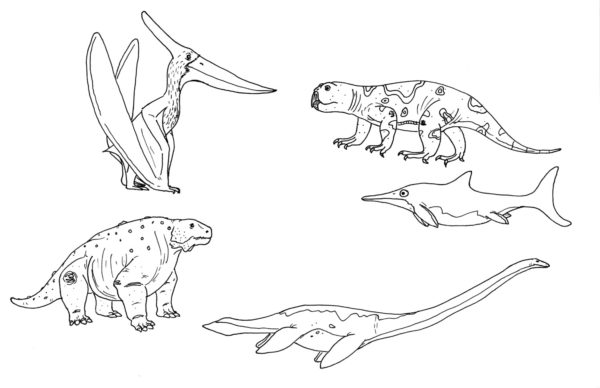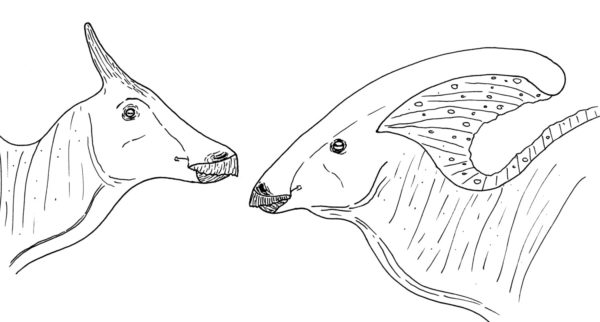
In 1842 the Victorian anatomist Sir Richard Owen established the taxon ‘Dinosauria’ to describe a group of distinct fossil reptile species from England. The term ‘dinosaur’ is a combination of two Ancient Greek words which are ‘deinos’ meaning ‘fearfully great’ and ‘sauros’ meaning ‘lizard’. You’ll often see ‘deinos’ translated as ‘terrible’, but it’s meant more as ‘terror-inducing to behold’ more than terrible in a mean, nasty, savage way.
We can’t really blame Owen for this slightly hyperbolic description. The only three dinosaur species known to him at the time were all big and featured prominent teeth, claws, and spikes. It would be over a century before we got used to the idea of small, feathery dinosaurs. The word ‘sauros’, however, has led to no end of confusion, and is just one of many such examples that has misled the general public about dinosaurs.
There are plenty of other fossil reptile groups that have the word ‘-saur’ in their names- plesiosaurs (‘near to lizards’), ichthyosaurs (‘fish lizards’), mosasaurs (‘Meuse river lizards’), pareiasaurs (‘cheek lizards’), rhynchosaurs (‘beaked lizards’), pterosaurs (‘winged lizards’)… The list goes on. Only one of these groups are actually true lizards though, and that would be the aquatic mosasaurs. By now you might be wondering why some of these things are lizards and some aren’t, and what it even takes to be called a true lizard in the first place.

Clockwise from the top left: Pterosaurs, rhynchosaurs, ichthyosaurs, plesiosaurs, and pareisaurs. All fossil ‘saurians’, none of them lizards. By Nicholas Carter
Lizards make up the reptilian order Squamata (as do snakes, which are really just a group of legless, earless lizards). Despite the variety of shapes and sizes that lizards come in, they all have a list of shared anatomical features like highly flexible skull hinges inherited from a single common forerunner, the ancestral squamate. Despite looking fairly dissimilar to any living lizard at first glance, mosasaurs have all the essential anatomy inherited from that same common ancestor, meaning they too are classified as true lizards. Dinosaurs, and all the other ‘saurians’ mentioned above, lack the required features in their anatomy, meaning they didn’t evolve from that ancestral first lizard, and they are each their own groups of reptiles.
So what gives with the whole lizard name? Seems a little misleading, doesn’t it? Strictly speaking, scientific names don’t have to reflect the ancestry of the taxa they’re given to. This is why dinosaurs can be named ‘fearfully great lizards’ when not all were fearfully great and they weren’t true lizards. I suspect that, when Owen coined the name, he was using ‘sauros’ in a somewhat loose and generic way, especially since the Ancient Greeks didn’t differentiate evolutionary lineages of organisms the way modern scientists do. Perhaps ‘sauros’ was, and still is, the ancient Mediterranean best term available for reptiles in general. While modern paleontologists continue to use ‘sauros’ in naming prehistoric creatures in all different lineages, you’ll often find in conversation they casually translate it more loosely as ‘reptile’ to avoid confusing people. Though it might not be a completely literal translation, I think it’s a good idea.
There’s all sorts of names out there in the taxonomic world that don’t accurately reflect the biology and evolution of the creatures they’re applied to. One interesting example is that of the fossil animal Basilosaurus. This Eocene giant was recognized as a large marine vertebrate, superficially similar to Mesozoic marine reptiles like pliosaurs and mosasaurs. With that size and similarity in mind, the beasts’ describer gave it its name which means “king lizard” (Harlan, 1834). Richard Owen, however, thought otherwise. He pointed out that the teeth of Basilosaurus were double-rooted and set in sockets, just like those of mammals. He identified the creatures as a primitive whale instead of a late-surviving marine reptile, and proposed the alternate name Zeuglodon for it (Owen, 1839). Unfortunately, once scientific names are established they can’t be changed except for special circumstances, or unless they’re found to already be occupied. And so, Basilosaurus must remain with the name it’s been given, despite being more closely related to you and me than any reptile.

Tylosaurus (top, ‘knob lizard’) and Basilosaurus (bottom, ‘king lizard’). Only one is a lizard, though. By Nicholas Carter
There’s the dinosaur Struthiosaurus, the name of which means ‘ostrich lizard’. With a name like that you might expect it was one of the ostrich-like ornithomimids. But this creature is actually an ankylosaur, a four-legged, heavily armored, plodding herbivore. It’s hard to imagine a less ostrich-like archosaur than this. The name was apparently chosen due to the dinosaur’s braincase which the author saw as similar to that of ostriches (Bunzel, 1871).
The well-known hadrosaur Parasaurolophus was named in reference to the earlier-described Saurolophus (which shows that it’s more proper to pronounce it ‘para-SAURO-lophus’ rather than the common ‘para-saur-OLO-phus’). Both of these are hadrosaurs that bear cranial ornamentation, which led to the belief that they must have been closely related (Parks, 1922). In actual fact, these species are on very different ends of the hadrosaur family tree, as the crest of Saurolophus is a small, solid structure evolved independently from the big, hollow crest of Parasaurolophus.

Saurolophus (left) and Parasaurolophus (right). Both are hadrosaurs with interesting head ornaments, but they aren’t each others closest relatives. By Nicholas Carter
Stegosaurus, a dinosaur just about everyone knows, has a name that means ‘roof lizard’. Yeah, ‘roof lizard’. Does this mean that Stegosaurus was busy hammering shingles and installing rafters all day? As amusing as that would be, the name reflects the initial thoughts on the dinosaur’s anatomy held by its discoverer, fossil baron O.C. Marsh. As one of the first animals of its kind ever found, the exact anatomy of Stegosaurus was a little puzzling at first. Marsh knew it was a large Mesozoic reptile with big, flat plates of bone, but initially believed the plates lay flat across the back, forming a roof-like shell (Marsh, 1877). As better material was discovered, however, Marsh eventually got closer to the truth of what Stegosaurus really looked like.
There’s more little examples of oddly-named fossil creatures. Pentraceratops (‘five-horned face’) had… Three horns. Arrhinoceratops (‘no nose-horn face’) has a nose horn. Oviraptor (‘egg seizer’) was a birdlike herbivore. Archelon (‘first turtle’), the giant marine turtle of the Late Cretaceous, was not actually the first turtle. So what’s the point here? What can we learn from all these misleading taxonomic labels?
Paleontology is a human activity (even the most out-there paleontologists are still human). Humans make sense of things using shortcuts and metaphors. And they make mistakes. This makes taxonomy a precarious field of science. Name something with a convenient label, like ‘sauros’, and the name’s set in stone. Mistake an ancient whale for a reptile and give it a name reflecting that misconception? Too bad, no going back. In this way, taxonomy does more than provide a means to name and classify living things. It also reflects the history of how humans have understood the species we’ve studied. It’s a science of stories and metaphors. Science is rarely perfect the first time around, instead it corrects itself bit by bit as different voices lend their observations. The point here is to not take scientific names too seriously. Just because a group of Mesozoic archosaurs are known as ‘terrible lizards’ doesn’t by definition make them lizards. We define organisms by their shared evolved characteristics, and hopefully our names reflect what we know about that. So don’t get too hung up on turbulent taxonomy, a dinosaur by any other name is still as neat.
By Nicholas Carter
References
Bunzel, E (1871). “Die Reptilfauna der Gosaformation in der Neuen Welt bei Wiener-Neustadt” (PDF). Abhandlungen der Kaiserlich-Königlichen Geologischen Reichsanstalt. 5: 1–18
Harlan, R. (1834). “Notice of fossil bones found in the Tertiary formation of the State of Louisiana”. Transactions of the American Philosophical Society. 4: 397–403.
Marsh OC (1877). “A new order of extinct Reptilia (Stegosauria) from the Jurassic of the Rocky Mountains”. American Journal of Science. 3 (14): 513–514
Owen, R. (1839). “Observations on theBasilosaurus of Dr. Harlan (Zeuglodon cetoides, Owen)”. Transactions of the Geological Society of London. 6: 69–79
Parks, W.A. (1922). “Parasaurolophus walkeri, a new genus and species of trachodont dinosaur”. University of Toronto Studies: Geological Series. 13: 5–32.

